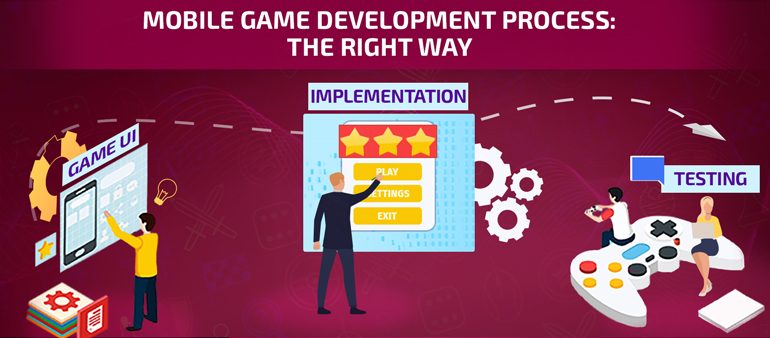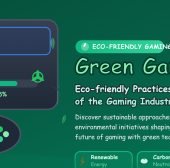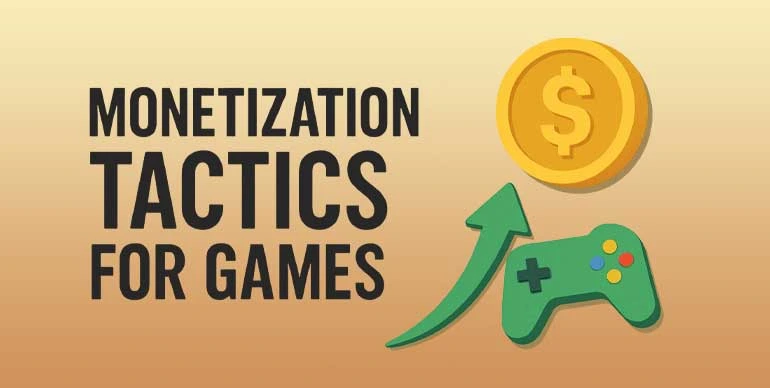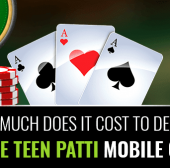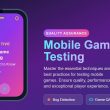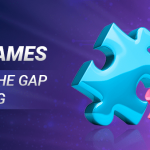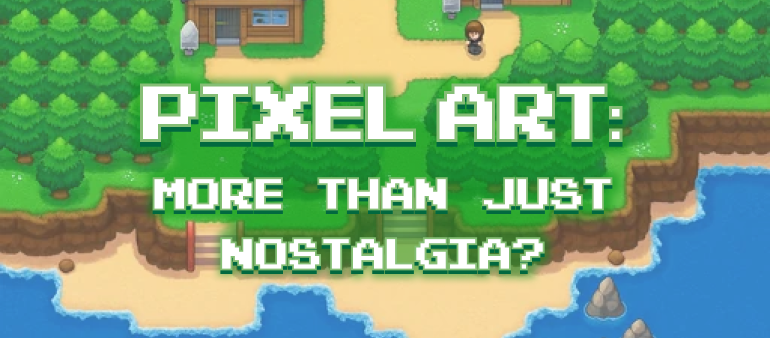Needless to say as we all know that mobile phones have become an integral part of our lives today. We can shop, we can hop and even get our hunger pangs off using mobile phones! There are endless things we can do with mobile phones today, but when we zero in on the most common ones, gaming gets the coveted spotlight.
As per the reputed market research firm Newzoo, the global mobile gaming industry was expected to generate $68.5 billion in 2019 and engulf half the gaming market by 2022. There’s no doubt that mobile gaming market is big, and a lot of businesses are venturing in game development to tap its huge monetization potential. However, building a mobile game is a serious business and no matter how creative your game idea is it will still fail if the execution is just not right. That said, I am discussing what the right mobile game development process could be so that you can plan your mobile-gaming quest better and successfully bring a new champion in the gaming market.
Three Stages of Mobile Game Development Process
- Pre-Production
- Production
- Post-production
These are three main phases of mobile game development or any game development for that matter. Each of them covers a set of tasks (which I am going to discuss next) that would help you cover the whats and whys to avoid creating a labyrinth for yourself in the process. So, are we all set? Let’s begin the ride then!
Pre-production
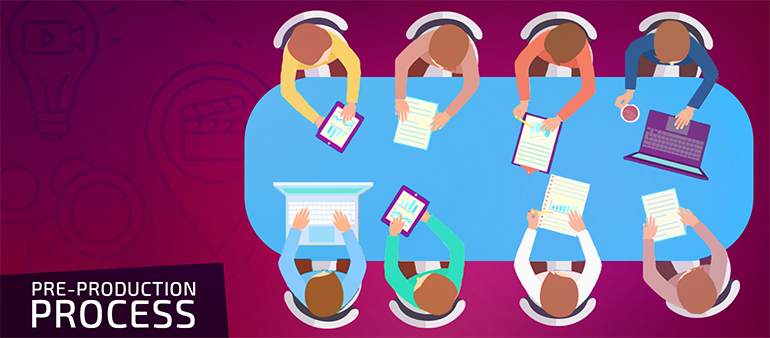
Pre-production is the initial stage that begins with a great game idea and conceptualization. On the basis of your in-depth market research, you decide what game will be produced, who your competitors are, will it be for console, PC or mobile and the budget required. I am assuming mobile as this blog is about the mobile game development process.
Pre-production lays the foundation for your mobile game as the most critical aspects are carefully thought upon at this stage, including game’s selling points, core game mechanics, fun factor, target audience, gameplay, storyline, game design, objects, sounds, UI, 2D/3D, technology, game engine, etc.
To choose the mobile platform, you need to figure out where your target audience exists. Most game app developers go for Android and iOS as these are the reigning mobile operating systems, but if your market research points out to Windows and Blackberry too, then you can build your game for them as well. In such a case, going for a cross-platform mobile app could be an ideal choice because native apps will take a lot of time plus they will be much more expensive to build. But again, this is subject to which and how many operating systems your target audience is using.
Now, as a standard, game concept designers, writers, developers, instructional designers and subject matter experts (SMEs) collaborate to create technical details of the pre-production stage to be implemented throughout the development process. And these technical details are covered under as follows:
- Concept documentation
- Game design document (GDD)
- Project plan
- Software Requirement Specification (SRS) Document
- Proof of Concept (POC)
- Architecture – Design
- Art-style
- Test-plan
However, these technical details are not supposed to be exhaustive as they can be revised based on changing requirements. You need to understand that mobile games are different from console games which have to be completed fully before they are shipped out. Mobile games, on the other hand, are more flexible as they can be developed in Alpha, Beta and Gamma stages. What it means is that you can make a prototype ready (a workable product with basic functionalities and features) and keep improving on feedback and changing requirements through updates and further releases. Basically, you break down the whole development in small chunks so as to build fast, market fast and learn fast to adjust from time to time and bring it up to the expectations of your users.
Did we forget something here? Oh yes! The team, its size and roles to undertake.
Well, choosing a team for your mobile game development depends on two factors:
- The size and complexity of your game
- The type of your game
If you are building a game of large scale, you may need to hire a big team, though, you can start with a small team too and recruit more going forward. The complexity of the game also factors in determining the size of the team. For example, if you’re planning to build an Augmented Reality/Virtual Reality mobile game, the team size will generally be greater than that of multiplayer board game developers or a team taking up casual puzzle game development or time management games development or card game development.
The second factor is the type of game you are going to develop. Based on the game type, you can establish specialized roles your team members need to undertake for the successful completion of the game. For example, if your game is story-rich with a big narrative, you would need to hire a writer(s) also, or a 3D modeller(s), 3D animator(s) and concept artist(s) for a 3D game.
In the pre-production process, you get to decide not just on the specialized roles of your team members and the quantum, but the hiring model as well, which brings us to understand the three ways of hiring employees.
Three Types of Hiring Models
Freelancers
In today’s connected world, a plethora of freelancers is available for hire on platforms such as UpWork and Freelancer. You can interview and choose candidates as per your needs and budget. However, finding a dream worker on such platforms may not be as easy as it may sound, at least initially.
In-house employees
You can hire an in-house team, but you may not want after considering the high cost and other disadvantages associated with it. You will have to pay a recruiter to quickly interview and hire specialists, bear the infrastructural costs, look into team-building activities and manage the team which will ultimately take your focus off from the core activities of your gaming business. The lone advantage is that you will get to communicate with your team face-to-face every day, which in return can contribute to your end product enormously.
Outsourcing/Offshoring
There are various reasons why outsourcing/offshoring has become a top choice for several businesses to hire game development services. First, you get to work with people who are specialists and have hands-on experience of delivering projects as yours. Second is low cost as you pay nothing for the infrastructural setup, interviewing and hiring employees, and motivating and rewarding them with parties and yearly appraisals. Besides, you get to hire resources on a need basis, which means you only pay for as many resources you currently need without dealing with a situation of firing and hiring often. Your offshore game design and development services provider will lay out everything explicitly in the contract including terms and conditions and SLAs, so the cooperation, quality and timely delivery are guaranteed.
Now that we know the essentials of the pre-production stage, it’s time to head to the next big stage, i.e. Production.
Production
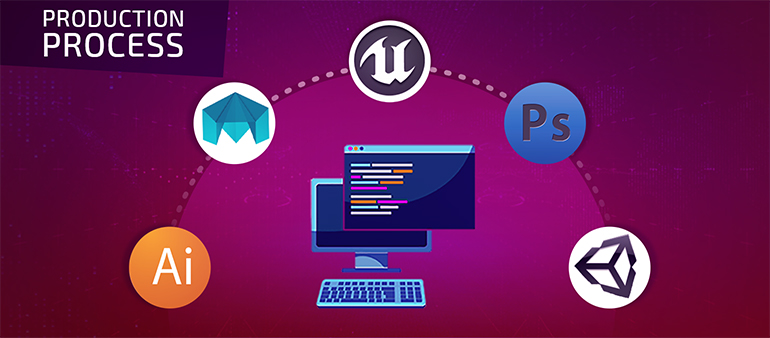
Once the plan of attack is ready, you bring your workforce into action to start building game architecture and modules based on priorities. That said, the role of product owner, product manager and project manager becomes important here as they crystallize what needs to be developed first to bring your game to viability. So, your team spends time on writing thousands-of-lines-of-source code to breathe life in each piece of in-game content and create art-assets, such as game characters, objects, background/environments, animations, audio and visual-effects (2D/3D).
Some popular tools for creating 2D art include Adobe Photoshop, Adobe Illustrator and SketchBook Pro, whereas for 3D art are 3DsMax, Maya, ZBrush and Marvelous Designer. If we talk about game engines, Unity and Unreal Engine are the most popular ones, but you can go for others as well based on your game requirements. The decision on choosing a game engine comes down to various factors like game complexity, features you need, availability of drag and drop functionality, visual scripting, team size, time frame, genre and budget.
Sprint planning is an important aspect of production as a workable product should ideally be made ready as soon as possible. The best way to achieve that is to work on small sprints and release a module every one or two weeks. Each sprint is reviewed for feedback and worked upon to improve. There will still be bits and pieces here and there to improve, but that’s alright as they can be improved in the next development stage.
Are you thinking about Funding options now?
If you have a tight budget, you can also opt for some funding options from here on by showing your demo product for investor review. Having a workable product ready can attract Angels and Seeds to invest in your game idea and eventually earn high ROI. You can also go for a crowdfunding campaign on Kickstarter, Indiegogo and many others where backers can support your game to make it a palpable reality.
So now, your team integrates all the modules and takes a plunge to the post-production stage.
Post-production
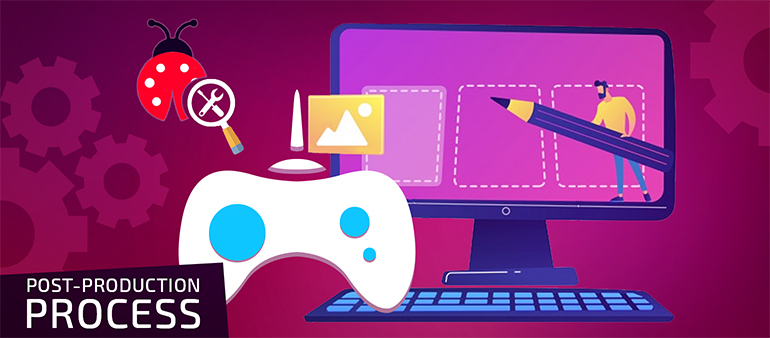
In the post-production stage, your team integrates 3rd party SDKs and optimizes the game. The stage is now set for game testing services and QAs get involved to identify and report bugs for fixes. And why only QAs for bug fixes, product manager and project manager also collaborate with the development team to improve the texture of objects, make explosions look more real, let the trees sway in the wind as they do in real-life scenarios and more. You finally lock the code and spend most of the time on polishing and completing the game to the hilt. These improvements, though minor, can greatly differentiate between what’s immersive and what’s not.
App Monetization
The next step is to work on monetization strategies. In-app purchases, Ads within the app and paid apps are the common examples of how most game developers monetize their apps for getting returns on their efforts and investments. Let’s take them one by one.
- In-app purchases: These are usually the part of freemium models, where users pay nothing to start playing your game, but they eventually do for various reasons, such as to move to advanced levels because they can’t wait for long to cross a difficulty level or need power-ups or more powerful game assets (like weapons, a more sophisticated car, etc). You can relate to it if you have played Candy Crush Saga and Clash of Clans.
- Advertisements: Ads within an app is also a good idea to make some money, but this may hamper user experience. One way to deal with this is to offer an option where users can pay to remove ads, though, only a few will be likely to do so. You can go for Admob for banner ads, and Unity for video ads that reward users.
- Paid app: You can also ask users to pay some price upfront to download your app. But there’s weird psychology among gamers as they will happily pay $50 for Angry Birds on Xbox, but balk at paying $0.99 for it in an app store. Freemium models are to be majorly blamed for this. Anyway, the key is to understand how your users will prefer to pay and work around your monetization strategies accordingly.
Marketing to help your Gaming App become a new Mania
The next step is to get the app ready for app store optimization (ASO) and submit on respective app stores. You uncork a bottle of Champagne and celebrate what you have waited so long for. Your marketing team takes on from here, but not invariably, as pre-launch marketing can also be done to create a buzz about what’s coming out. Game marketing strategies play a big role in creating a buzz about your game and maximize your reach.
You must dedicate a portion (but sufficient enough) of your game development budget to run marketing campaigns on social media, offer perks to try your game and even run paid ads to reach out to your target audience. Your mobile game resides in app stores, but creating a home on the web can also do wonders to increase the number of installs. What it implies here is a landing page on the web. There is no single environment that users experience, which is why creating a landing page on the web could turn out to be a very effective marketing strategy to reach out to prospective users and coax them to install your gaming app from there. You also get email addresses of your potential users which you can use for email marketing purposes and make them aware of future releases and updates,
Some of the key components to keep in mind while creating a landing page for your app are as follows:
- Head-turning headlines
- Relevant keywords
- Eye-catchy images
- Social sharing buttons
- Smartly placed CTAs
It’s a stark fact that in today’s digital world people prefer to spend more time watching videos than reading walls of text. So, you can ask your designing team to create video previews of your game so that the marketing team can share them on popular platforms like YouTube, Daily Motion, Vimeo, and others. Video content is a good alternative to text-based descriptions as users can quickly see the best pieces of your video game and immediately decide whether or not to install your gaming app.
You should also listen to what your users have to say about your game. One way of doing that is to create forums where players can discuss both positives and negatives of your game. This will only help your marketing team understand what’s working well and what needs to be done next to improve user experience and build trust among both old and new players.
Remember, a release is just the beginning of the long road and it’s very unlikely to create success without marketing activities. I will next write a separate blog on what the right marketing strategy could be to promote and bring a mobile game to fruition.
Support and Maintenance
A mobile game is never complete, so you would still need a small team of developers and testers to take care of support and maintenance. As you continue to learn something or the other from the feedback of your users, you will want to incorporate it in your game via future updates and releases. If we take modern hit games into consideration, two-five weeks is the average time to release updates. Updates are critical as they add more value to your game and greatly help in user retention.
The Game is getting Big and You need Funds to Scale
If shortage of money is holding you back from further supporting, expanding and marketing your game, post-launch is ideally the right stage to reach out to VCs and seek investments via Series A, B and C rounds of funding. Your marketing team is supposed to have built a suffice user base by now to make VCs believe and invest in your product. In case, you don’t want to share profits with others in lieu of investments, crowdfunding is still a good option to go for to scale your game and make it a revenue-generator machine.
Whew!!! With this, we have covered almost all the major areas of a mobile game development process. Now, if you’re a startup gaming company or even an established one looking forward to getting started on your next breathtaking mobile game idea, finding an expert game app development company might be ringing in your head. Don’t worry! Logic Simplified keeps you covered here!
Breathe Life in Your Mobile Game Idea with Logic Simplified
Logic Simplified, a game development company, based in Dehradun, India, offers game designers for hire, iPhone game developers, Android game developers and windows phone game app developers to gaming businesses of all sizes world over. Experts at LS will help you create a GDD and fill the gaps wherever required, along with offering you a vital piece of advice on tech-stack and scalability. Since gaming is what we think about and do all day long, we can effectively help you with feasible social and viral hooks as well.
We know the importance of responsive apps to feel home on different screen sizes, therefore also offer HTML5 game development services (both 2D and 3D) to fit mobile screens of all sizes. Unity game development is at the core of our game development services, but we have also excelled over the years at Adobe game development, Unreal and many more. In today’s modern times, more and more games are leveraging Artificial Intelligence (AI) and Machine Learning (ML) to make their game smarter and more immersive, and we are no way left behind in using new revolutionary technologies. In fact, LS has developed AI bots for its own card game app Gamentio and can help you too with AI development for video games. Whether you’re looking for development of multi-player 2D & Mmorpg 3d game or an action game, role-playing game (RPG), shooting game and whatnot, Logic is a go-to studio to meet all your gaming needs, even for console and handheld games development. Is there still something keeping you on the fence? Reach out to us at enquiry@logicsimplified.com to discuss your game idea, and we promise to get back to you shortly to tell you everything that will help you make a decision and begin with your mobile game development process outright.
 Get a Quote
Get a Quote

